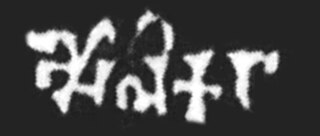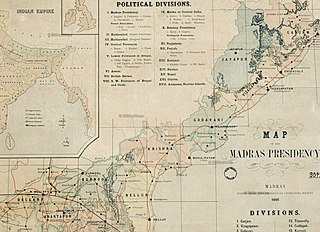
Jharkhand is a state in eastern India. The state shares its border with the states of West Bengal to the east, Chhattisgarh to the west, Uttar Pradesh to the northwest, Bihar to the north and Odisha to the south. It is the 15th largest state by area, and the 14th largest by population. Hindi is the official language of the state. The city of Ranchi is its capital and Dumka its sub-capital. The state is known for its waterfalls, hills and holy places; Baidyanath Dham, Parasnath, Dewri and Rajrappa are major religious sites. Jharkhand is primarily rural, with about 24% of its population living in cities.
Vikram Samvat, also known as the Vikrami calendar is a Hindu calendar historically used in the Indian subcontinent and still used in several states. It is a solar calendar, using twelve to thirteen lunar months each solar sidereal years. The year count of the Vikram Samvat calendar is usually 57 years ahead of the Gregorian calendar, except during January to April, when it is ahead by 56 years.

Nagpuri is an Indo-Aryan language spoken in the Indian states of Jharkhand, Chhattisgarh, Odisha and Bihar. It is primarily spoken in the west and central Chota Nagpur plateau region. It is sometimes considered a dialect of Bhojpuri.
The region have been inhabited since the Stone Age. Copper tools from the Chalcolithic period have been discovered. This area entered the Iron Age during the mid-2nd millennium BCE.

The Rohtasgarh or Rohtas Fort is located in the Son River valley, in the small town of Rohtas in Bihar, India.

The Aulikaras, also referred to as Aulikara dynasty or Olikara dynasty, were an ancient Indian clan from the Maurya era, that emerged into a kingdom between the 4th-century CE and 6th-century CE. They were based in the Malwa (Malawa) region of central India near Mandsaur, with their power center near what is now western Madhya Pradesh, southeastern Rajasthan and northeastern Gujarat. Two royal houses belonging to this clan ruled over the present-day western Malwa region of Madhya Pradesh state from c. 350 CE to 550 CE, much of it as feudatories of the Gupta Empire.
Kharwar is a community found in the Indian states of Uttar Pradesh, Bihar, Jharkhand, Chhattisgarh, Orissa and West Bengal.

Aharji is a historical pilgrimage site for Jainism in India. It is located in the central Indian state of Madhya Pradesh, on the road from Tikamgarh to Chhatarpur. This place is famous for Jain Temple.
Khasa-Malla kingdom, popularly known as Khasa Kingdom and Yatse in Tibetan, was a medieval kingdom from the modern day far-western Nepal and parts of Uttarakhand state in India, established around the 11th century. It was ruled by kings of Khasa tribe who bore the family name "Malla". The Khasa Malla kings ruled western parts of Nepal during 11th–14th century. The 954 AD Khajuraho Inscription of Dhaṇga states that the Khasa Kingdom were equivalent to the Gaudas of Bengal and the Gurjara-Pratihara dynasty.

Bulu Imam is an environmental activist working for the protection of tribal culture and heritage in Jharkhand. On 12 June 2012, he received the Gandhi International Peace Award, 2011 at the House of Lords in London. He is also a recipient of the Padma Shri (2019). He is the grandson of Syed Hasan Imam, who was a leading Barrister and Judge of Calcutta High Court (1912–1916), and the President of the Indian National Congress. His daughter, Cherry is married to Kunwar Ashish Bir Singh Tekari of Tekari Raj.
Chandel or Chandela is a Rajput clan from India. Families belonging to this clan ruled several kingdoms in north India and held various feudal estates. The most notable of these were the Chandelas of Jejakabhukti, who ruled the Bundelkhand region.

The Kalachuris of Ratnapura were a central Indian dynasty during 11th and 12th centuries. They ruled parts of present-day Chhattisgarh from their capital at Ratnapura. They were an offshoot of the Kalachuris of Tripuri, and ruled as vassals of the parent dynasty for many years.
The Nagvanshis of Chotanagpur, also known as the Khokhra chieftaincy, was an Indian dynasty which ruled the parts of Chota Nagpur plateau region during much of ancient, medieval and modern period. Phani Mukut Rai is considered the first king of dynasty claim to be son of Pundrika Naga, a mythical Naga. Lal Chintamani Sharan Nath Shahdeo (1931–2014) was last ruling king of the dynasty, until the estate was merged to the Republic of India.
The Nagpuria people, also Nagpuri or Sadan, are an Indo-Aryan speaking ethnolinguistic group who are the native speakers of the Nagpuri language and natives of the western Chota Nagpur Plateau region of Indian states of Jharkhand, Bihar, Chhattisgarh and Odisha.
The Kol uprising, Kol rebellion, also known in British records as the Kol mutiny was a revolt of the tribal Kol people of Chhota Nagpur that took place between 1831 and 1832. It was due to economic exploitation brought on by the systems of land tenure and administration that had been introduced by the East India Company. Tribal people of Chotanagpur including Mundas, Oraons, Hos and Bhumijs were called Kols. They initially plundered and killed Sikh and Muslims thikedars (contractors) who collected taxes by different means. Later they also started to plunder and kill Hindus of nearby villages and burn their houses. The insurgency was suppressed by killing of the leaders, their followers and arrest of many leaders by Thomas Wilkinson.

Jeypore Estate or Jeypore Zamindari was a Zamindari estate of the Madras Presidency in British India. Historically it was a kingdom known as Jeypore Kingdom, located in the highlands of the western interiors of the Kalinga region that existed from the mid-15th century to 1777 CE. It was earlier a tributary state of the Gajapati Empire and following its decline in 1540, it gained sovereignty and later became a tributary state of the Qutb Shahis until 1671. The kingdom regained degrees of semi-independence until it became a vassal state of the British in 1777. It eventually formed a part of the linguistic Orissa Province in 1936 upon transfer from the Madras Province and became a part of the independent Union of India in 1947.
Pratap Dhavala was Khayaravala king in 12th century. There are inscription of Pratapdhavala in Phulwaria, Tutrahi fall rock inscription of Vikram Samvat 1214, Tarachandi rock inscription of Vikram Samvat 1225.
Shri Pratapa was Khayaravala king in 13th century. There are inscription of Shri Pratapa in Rohtas of Vikram Samvat 1279. According to inscription he defeated a "Yavana" army; the "Yavana" here probably refers to a Muslim general. According to the inscription of Rohtas Fort, Shri Pratapa was descendant and successor of Pratapdhavala.
Baghdeo Singh was founder of Ramgarh Raj in North Chotanagpur. He was king of Khayaragarh. He was made Fauzdar of Karra under the Nagvanshi. He suppressed rebellion in Tamar for Nagvanshi ruler. Nagvanshi send him to extract taxes from Karpurdeo the king of Karnpura. Baghdeo killed Karpurdeo and he declared himself as the King of that region.
Gajghat Rai was Nagvanshi king in 9th century. He succeeded Gajdant Rai.









